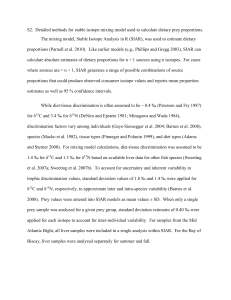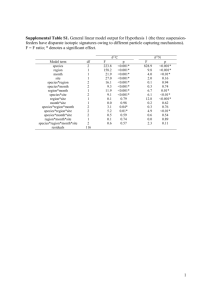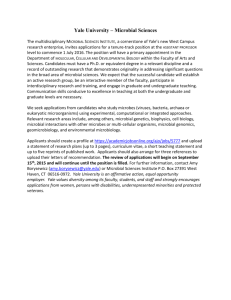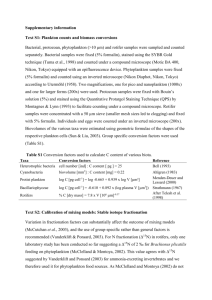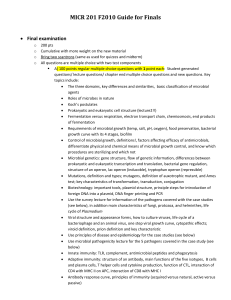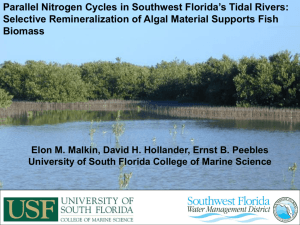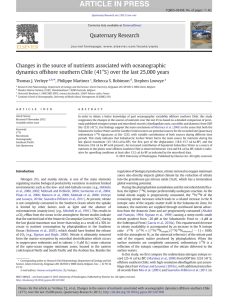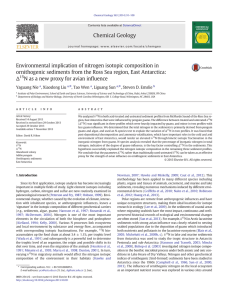CSIA of nitrogen containing lipids and their amino acid precursors
advertisement
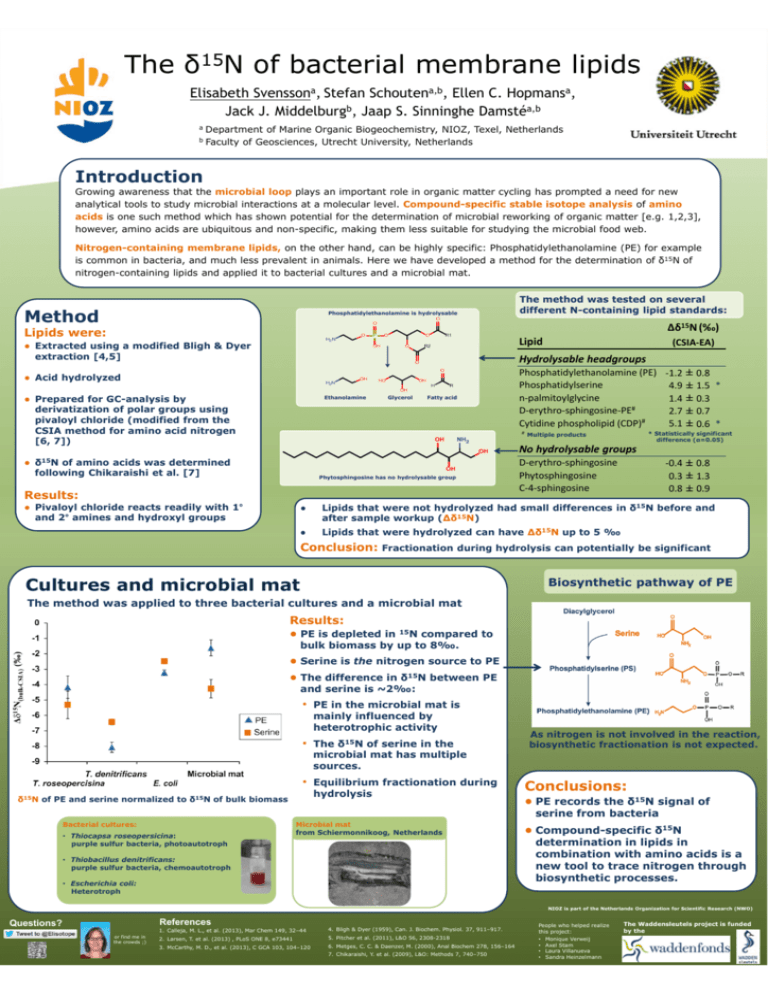
The δ15N of bacterial membrane lipids Elisabeth Svenssona, Stefan Schoutena,b, Ellen C. Hopmansa, Jack J. Middelburgb, Jaap S. Sinninghe Damstéa,b a b Department of Marine Organic Biogeochemistry, NIOZ, Texel, Netherlands Faculty of Geosciences, Utrecht University, Netherlands Introduction Growing awareness that the microbial loop plays an important role in organic matter cycling has prompted a need for new analytical tools to study microbial interactions at a molecular level. Compound-specific stable isotope analysis of amino acids is one such method which has shown potential for the determination of microbial reworking of organic matter [e.g. 1,2,3], however, amino acids are ubiquitous and non-specific, making them less suitable for studying the microbial food web. Nitrogen-containing membrane lipids, on the other hand, can be highly specific: Phosphatidylethanolamine (PE) for example is common in bacteria, and much less prevalent in animals. Here we have developed a method for the determination of δ15N of nitrogen-containing lipids and applied it to bacterial cultures and a microbial mat. Method Phosphatidylethanolamine is hydrolysable The method was tested on several different N-containing lipid standards: Δδ15N (‰) Lipids were: Lipid ● Extracted using a modified Bligh & Dyer extraction [4,5] (CSIA‐EA) Hydrolysable headgroups ● Acid hydrolyzed ● Prepared for GC-analysis by derivatization of polar groups using pivaloyl chloride (modified from the CSIA method for amino acid nitrogen [6, 7]) Ethanolamine Glycerol Fatty acid Phosphatidylethanolamine (PE) ‐1.2 ± 0.8 Phosphatidylserine 4.9 ± 1.5 * n‐palmitoylglycine 1.4 ± 0.3 D‐erythro‐sphingosine‐PE# 2.7 ± 0.7 Cytidine phospholipid (CDP)# 5.1 ± 0.6 * # * Statistically significant difference (α=0.05) Multiple products No hydrolysable groups ● δ15N of amino acids was determined following Chikaraishi et al. [7] Phytosphingosine has no hydrolysable group Results: ● Pivaloyl chloride reacts readily with 1° and 2° amines and hydroxyl groups ‐0.4 ± 0.8 0.3 ± 1.3 0.8 ± 0.9 D‐erythro‐sphingosine Phytosphingosine C‐4‐sphingosine ● Lipids that were not hydrolyzed had small differences in δ15N before and after sample workup (∆δ15N) ● Lipids that were hydrolyzed can have ∆δ15N up to 5 ‰ Conclusion: Fractionation during hydrolysis can potentially be significant Cultures and microbial mat Biosynthetic pathway of PE The method was applied to three bacterial cultures and a microbial mat Results: ● PE is depleted in 15N compared to bulk biomass by up to 8‰. ● Serine is the nitrogen source to PE ● The difference in δ15N between PE and serine is ~2‰: • PE in the microbial mat is mainly influenced by heterotrophic activity • The δ15N of serine in the microbial mat has multiple sources. • Equilibrium fractionation during hydrolysis δ15N of PE and serine normalized to δ15N of bulk biomass As nitrogen is not involved in the reaction, biosynthetic fractionation is not expected. Conclusions: ● PE records the δ15N signal of serine from bacteria Bacterial cultures: • Thiocapsa roseopersicina: purple sulfur bacteria, photoautotroph Microbial mat from Schiermonnikoog, Netherlands • Thiobacillus denitrificans: purple sulfur bacteria, chemoautotroph • Escherichia coli: Heterotroph ● Compound-specific δ15N determination in lipids in combination with amino acids is a new tool to trace nitrogen through biosynthetic processes. NIOZ is part of the Netherlands Organization for Scientific Research (NWO) References Questions? or find me in the crowds ;) 1. Calleja, M. L., et al. (2013), Mar Chem 149, 32–44 4. Bligh & Dyer (1959), Can. J. Biochem. Physiol. 37, 911–917. 2. Larsen, T. et al. (2013) , PLoS ONE 8, e73441 5. Pitcher et al. (2011), L&O 56, 2308-2318 3. McCarthy, M. D., et al. (2013), C GCA 103, 104–120 6. Metges, C. C. & Daenzer, M. (2000), Anal Biochem 278, 156–164 7. Chikaraishi, Y. et al. (2009), L&O: Methods 7, 740–750 People who helped realize this project: • • • • Monique Verweij Axel Stam Laura Villanueva Sandra Heinzelmann The Waddensleutels project is funded by the

